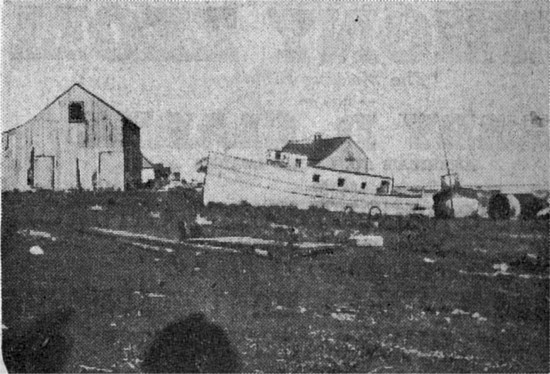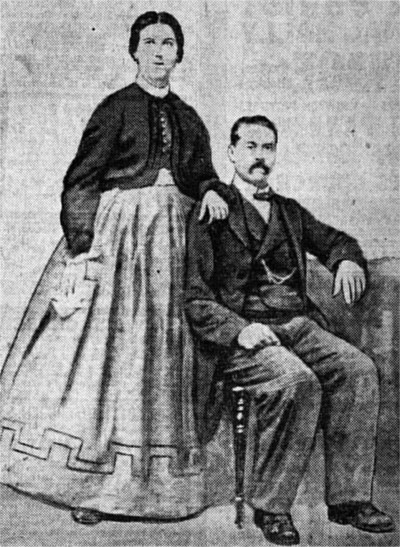Island Farming Had Its Shadows, 14 May 1949
Schooner Days DCCCIC (899)
By C.H.J. Snider

'Twas tedious work flailing out a thousand bushels of grain, and during the vice-regency of Simon or Sanford Davis while Capt. John Walters was lessee of the Main Ducks it was decided to get an "open cellar" horsepower thrashing machine on to the island. Davis knew where one could be rented across the lake. Two Port Ontario, N.Y., brothers, who had fished out of Point Traverse and the Ducks, were despatched with a small sloop fish-carrier to get it. Port Ontario was, even then, eighty years ago, a decaying harbor thirty miles from Oswego, which had flourished and faded in an early boom. They took with them a man named Howard, of Bath up the Bay, and Henry Selleck, of Point Traverse, 27-year-old farmer of Loyalist extraction, likely a great grandson of Capt. Charles Selleck, of the schooner Lady Murray, who settle at Presqu'Ile before 1797.
The name, long connected with lake sailing, is also spelled Sellicks and Selix. Both Canadian wives clung to their husbands and urged them not to go, but – you know what men are. They promised to come back.
The sloop was too small to attempt to get the thrasher down her single hatchway, even if it were dismantled, so it was placed on deck athwartships, and made fast to the bulwarks, the mainboom being topped up to clear it. They waited till Aug. 31st, 1868, for fair weather for the hazardous run of about twenty miles. With the Main Duck in sight a thundersquall struck them. The sloop, top heavy with her awkward deckload and raised boom, capsized, filled with water, and sank under their feet. She had no boat. All there was to cling to was an oar and a loose hatchcover. It would barely float two.
On the island they waited a long time for the sloop with the thrasher. They were patient there. Sometimes in off seasons they would send out their mail in sealed bottles, to be delivered or posted by whoever picked them up. Often they were glad of newspapers a month old, floated across from Point Traverse by a log raft.
But no fishcarrier or passing schooner or piece of driftwood brought information, and one of the Davises at last sailed over to Point Traverse to make inquiries.

A newspaper said that Howard's body had been washed up in front of his home, away up in Bath on the Bay of Quinte, as though keeping his word with his wife that he would come back. One of the Port Ontario men had turned up in Prince Edward and said yes, the sloop had capsized, but he couldn't very well say what had followed. He was washed up unconscious, or picked up unconscious, he didn't say where, but thought his brother would know. Brother had gone back to Port Ontario.
Then Henry Selleck's body came floating to the doorstep where his young widow waited for him in her father's house on the Babylon shore of Prince Edward County, west from Port Traverse, where, four houses clustered for company, and a fifth looked wistfully at them from the west.
She was Philip Dulmage's daughter, born by the hollow sounding waves and fated to suffer much from the water. She had thus lost her husband. Ten years later her youngest brother, a strapping young sailor, was swept out of the anchorage at Point Traverse in a wild Hallowe'en gale, and was found mounded in ice, frozen in his yawlboat under Stony Point light, on the farther side of the lake. It was Capt. John Walters who brought his body home for burial. Twenty-five years afterwards, when her baby Johnny, orphaned so young, had, grown to man's estate and was a seasoned sailor, he also was lost with all his shipmates, when the Toronto schooner Emerald vanished without a trace on the last trip of the season, in November, 1903. He and Edwin Ashley had been persuaded to join her in Oswego for one more trip, instead of coming home with their home schooner the Annie Minnes.
It added to her suffering that her young husband's body came ashore with the fingers contorted like claws, bruised and broken. It bespoke a final agony of which she was well spared the details.
Afterwards a shaky man babbled hysterically in a barroom that they would all have been drowned if they had not beaten Henry Selleck's hands off the edge of the hatchcover with an oar handle when three of them were clinging to it. Henry sleeps quietly in South Bay Cemetery beneath the stone his young wife provided for him, contented that he also kept his word to come back to her.
